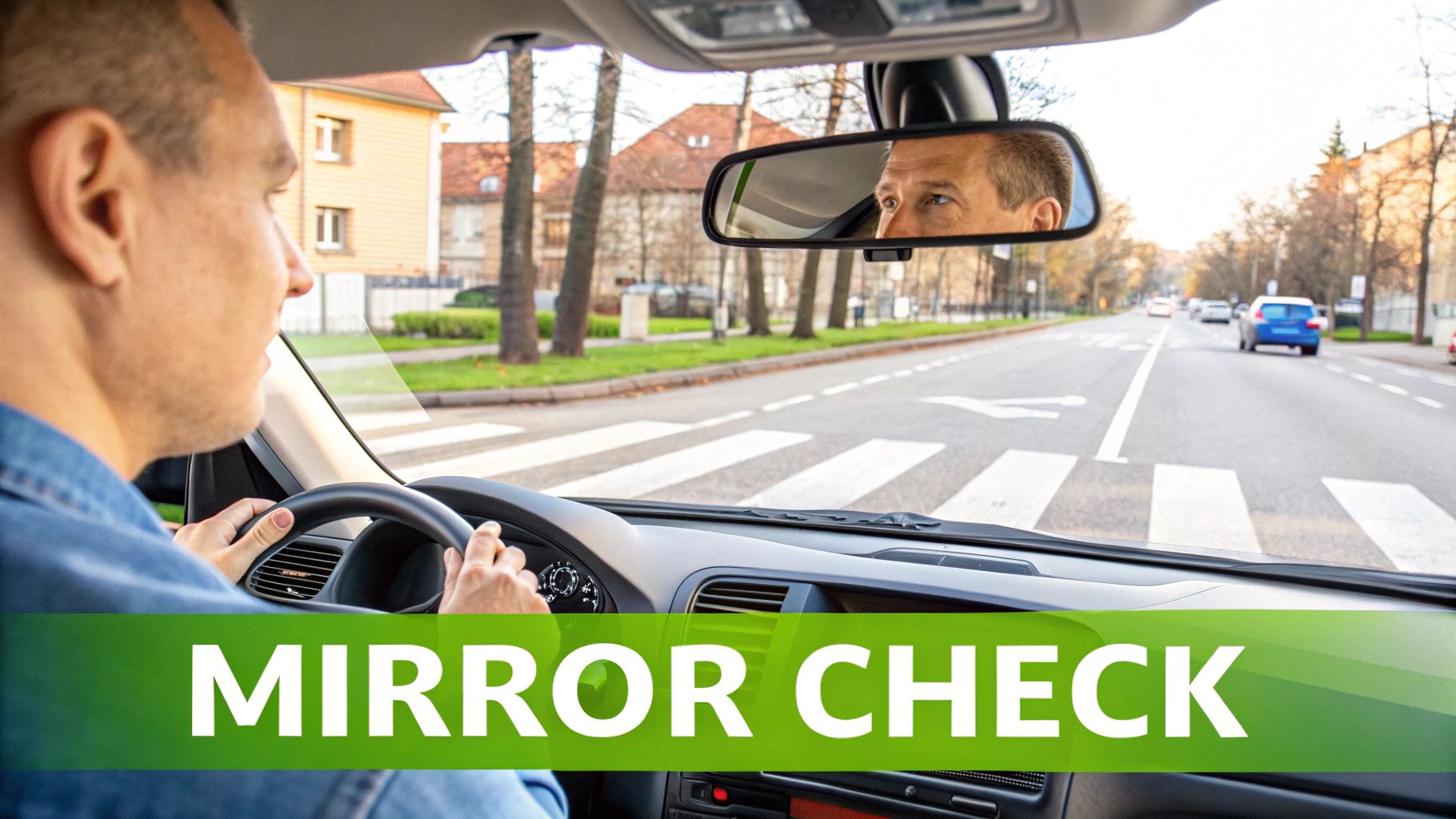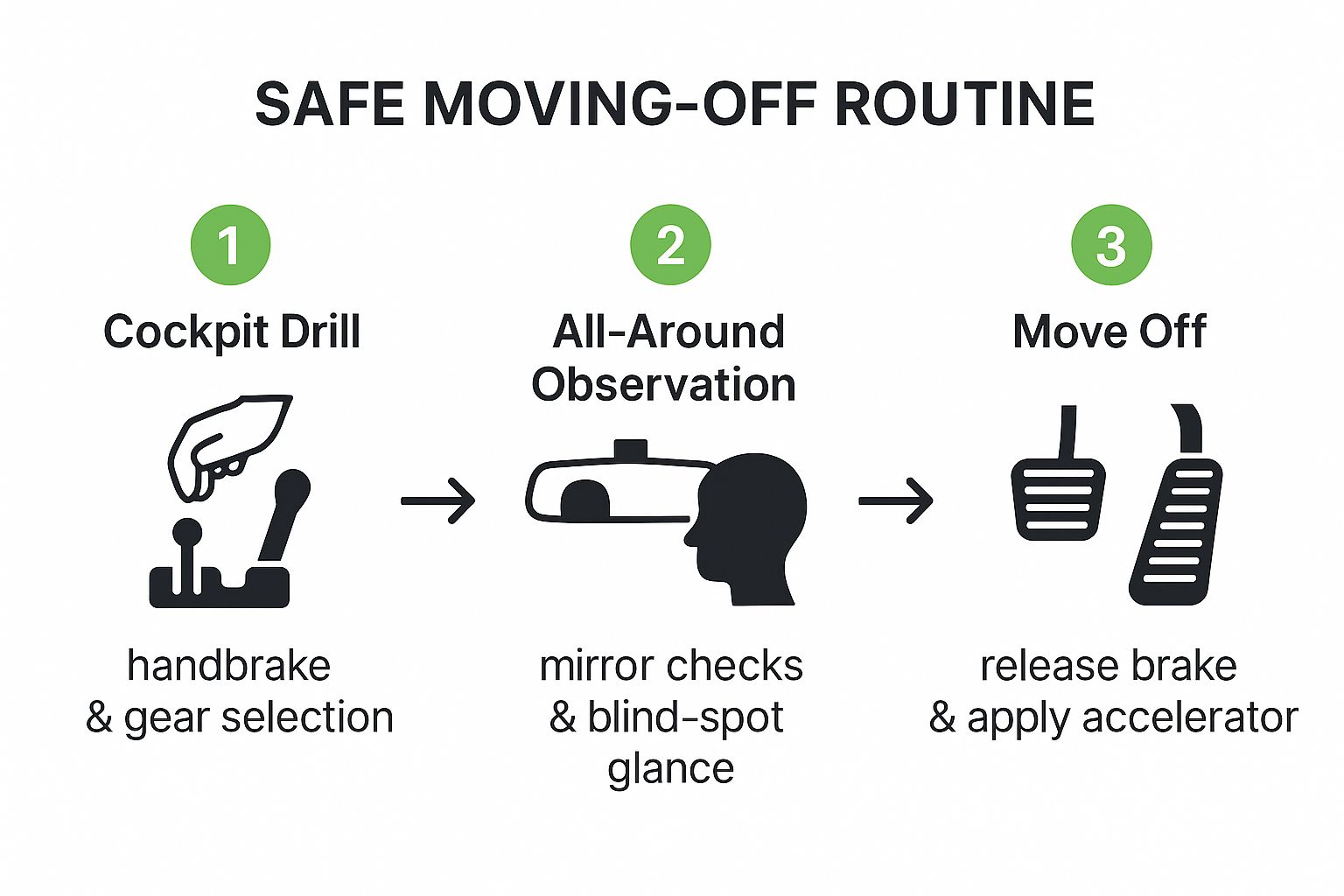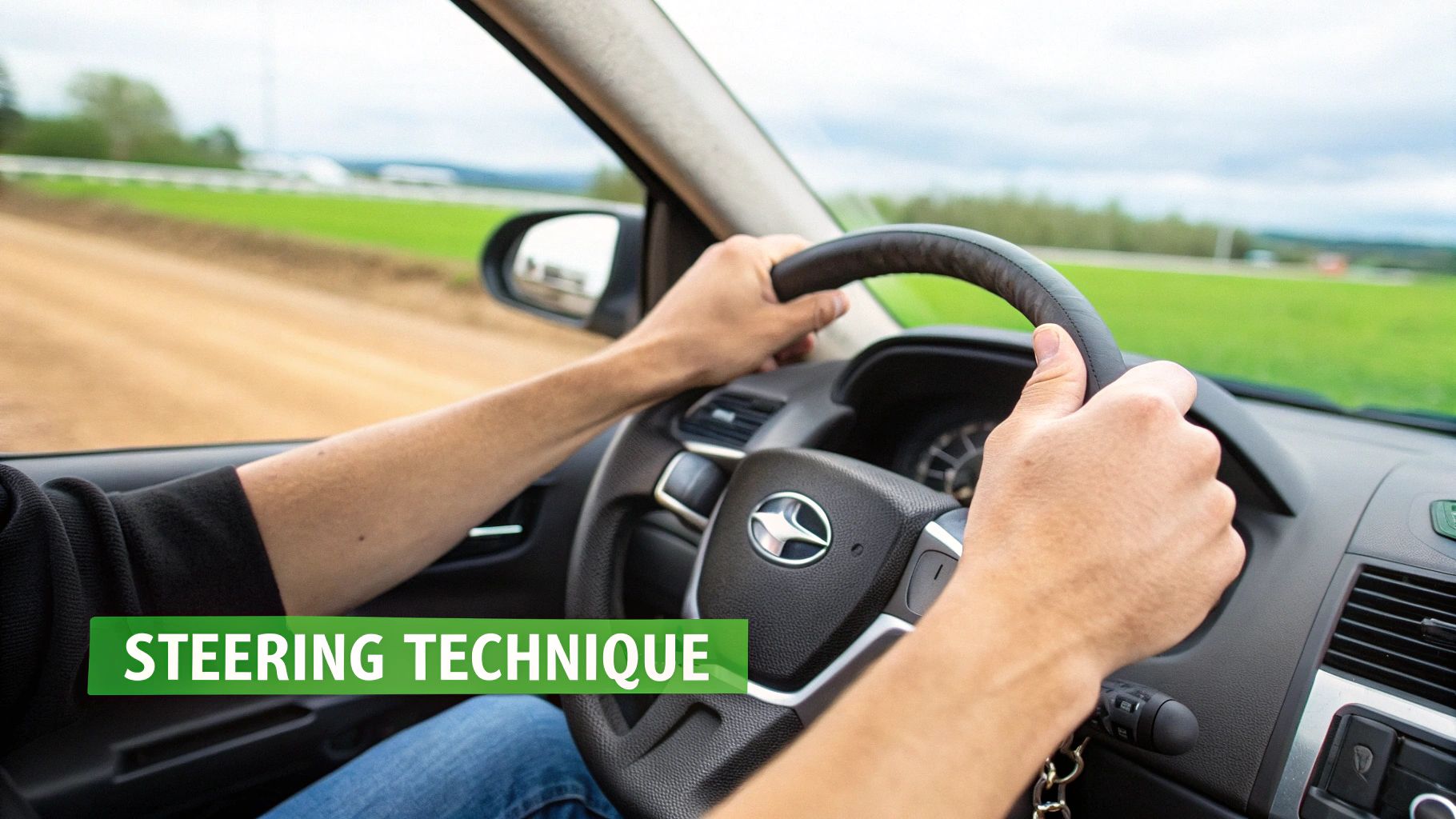Ace Your Driving Test: Steer Clear of These Common Driving Test Mistakes
Passing your UK driving test is a significant achievement, but common driving test mistakes can easily lead to failure. This listicle identifies six frequent errors, helping you avoid them and pass with confidence. Understanding these key areas, from observation and speed management to junction positioning and steering control, is crucial for success. This guide provides the insights you need, whether you're a new learner, retaking your test, or looking for intensive driving courses.
1. Inadequate Observation
Failing to properly observe your surroundings is the single most common driving test mistake, and a major contributor to accidents on UK roads. This isn't just about occasionally glancing in your mirrors. It's about developing a systematic approach to scanning your environment, anticipating potential hazards, and demonstrating to the examiner that you're aware of everything happening around your vehicle. This includes regular mirror checks, thorough blind spot checks before any manoeuvre, and actively scanning intersections for pedestrians, cyclists, and other vehicles. Examiners are particularly vigilant about observation techniques because they directly relate to safe driving practices. A lapse in observation can lead to dangerous situations and is often the difference between a pass and a fail.

This mistake deserves its top spot on the list of common driving test errors due to its frequency and potential consequences. Features of inadequate observation include missing mirror checks before signalling, changing speed, or direction; failing to conduct proper blind spot checks (shoulder checks); not scanning intersections thoroughly before proceeding; and overlooking pedestrians, cyclists, or other vulnerable road users. These seemingly small errors can accumulate quickly, leading to a failed test. More importantly, they translate into real-world dangers once you're driving independently.
Cons of Inadequate Observation:
- Immediate test failure: If observation errors create a dangerous situation during your test, you'll likely fail immediately.
- Accumulation of minor faults: Even less severe observation issues can accumulate minor faults, ultimately leading to a fail.
- Genuine safety risks: Poor observation creates real safety risks for yourself, your passengers, and other road users.
Examples of Inadequate Observation:
- Changing lanes without checking mirrors and blind spots.
- Pulling away from the curb without properly observing oncoming traffic or pedestrians.
- Not checking mirrors when approaching crosswalks or traffic lights.
- Entering a roundabout without adequately assessing the traffic flow.
Tips to Improve Observation:
- Establish a routine: Aim to check your mirrors every 8-10 seconds, regardless of the road conditions. This helps build a crucial habit.
- Verbalise your observations: During practice sessions, say out loud what you see in your mirrors and what checks you're performing. This reinforces the process and helps embed it in your memory.
- MSM Routine: Remember the MSM routine – Mirror, Signal, Manoeuvre – for all driving actions, even if you think a manoeuvre is simple or the road appears clear.
- Six-Point Check at Intersections: Practice the 'six-point check' at intersections: look left, centre, right, left mirror, right mirror, and rearview mirror. This systematic approach ensures you've covered all angles.
Whether you're a beginner learner, retaking your test, or simply looking to brush up on your skills, mastering observation is crucial for both test success and safe driving on UK roads. This proactive approach will not only help you pass your test but will also make you a safer and more confident driver.
2. Inappropriate Speed Management
Speed management is a crucial aspect of safe and competent driving, and errors in this area are a common reason for driving test failures. This encompasses more than just avoiding speeding tickets; it's about demonstrating appropriate judgment and control by adapting your speed to the prevailing road conditions and adhering to posted limits. Inappropriate speed management is a frequent driving test mistake, landing it firmly on this list, and can manifest in two key ways: driving too fast and too slow. Both can signal a lack of control and awareness to the examiner.
Driving too fast, particularly exceeding the speed limit in high-risk areas such as school zones or residential streets, is a major fault and will likely result in an immediate fail. Even on roads with higher speed limits, driving too fast for the conditions – for example, maintaining a high speed in heavy rain or fog – demonstrates poor judgment and can be equally detrimental to your test result. Conversely, driving too slowly can also be problematic. While it might seem safer, crawling along at an unnecessarily slow pace can disrupt traffic flow, create hazards for other road users, and suggest a lack of confidence and understanding of road dynamics. This can lead to progressive faults, accumulating throughout the test and ultimately leading to a fail.
Features of Speed Management Issues:
- Exceeding posted speed limits: This is the most obvious manifestation and a serious error.
- Driving too slowly without justification: Obstructing traffic by driving excessively slowly when conditions don't warrant it.
- Failing to adjust speed for weather, visibility, or traffic conditions: Maintaining the same speed regardless of rain, fog, heavy traffic, or other hazards.
- Inconsistent speed maintenance, especially on inclines or descents: Struggling to maintain a steady speed, particularly on hills.
Consequences of Poor Speed Management:
- Major fault for speeding, particularly in high-risk areas: An immediate fail on your driving test.
- Progressive faults for repeatedly driving below appropriate speed: Accumulation of minor faults leading to an overall fail.
- Shows poor vehicle control and judgment capabilities: Demonstrates a lack of preparedness for independent driving.
Examples of Inappropriate Speed Management:
- Entering a 20mph school zone at 30mph.
- Maintaining 40mph on a clear, dry national speed limit road (70mph). While not illegal, driving significantly below the speed limit for no reason can be disruptive and demonstrate poor judgment.
- Driving 15mph on a 30mph road with no obstructions or hazards.
Tips for Effective Speed Management:
- Regularly scan for speed limit signs and check your speedometer: Make this a constant habit.
- Practice speed awareness by maintaining consistent speeds without constantly checking the speedometer: Develop a feel for appropriate speeds.
- Learn proper speed selection for different road types and conditions: Understand how weather, traffic, and road surfaces impact safe speeds.
- Position the car to have clear views of speed signs: Anticipate speed limit changes and adjust accordingly.
This emphasis on appropriate speed management is reflected in national driver education programmes like speed awareness courses offered by the UK's National Speed Awareness Scheme, highlighting the importance of this skill. Similarly, the NHTSA speed management programmes in the US underscore the critical role of speed management in road safety. Mastering speed management is essential not just for passing your driving test, but for becoming a safe and responsible driver. For learner drivers, especially those taking intensive courses or retaking their test, focusing on speed management is paramount to success. Even seemingly small errors in this area can have significant consequences, making it a crucial skill to practice and perfect.
3. Poor Positioning at Junctions
Incorrect positioning at junctions is a common driving test mistake and a significant reason why many learner drivers fail their practical test. It demonstrates a lack of understanding of fundamental road positioning principles and creates hazardous situations for yourself and other road users. This encompasses several key areas, including stopping in the wrong place at stop signs and traffic lights, choosing the incorrect lane for your intended direction, and adopting improper road position when turning or proceeding straight at intersections. This mistake deserves its place on this list due to its potential to cause confusion, lead to serious faults during the test, and ultimately endanger road users.

Several features characterize poor positioning at junctions: stopping too far forward or too far back at junctions; selecting the wrong lane for your intended route (e.g., being in the right-turn lane but intending to go straight); poor positioning during right or left turns, such as cutting corners; and driving too close to parked vehicles or other obstacles. For example, stopping beyond the advanced stop line at a traffic light signals a lack of observation and control. Positioning yourself in the right-turn lane and then attempting to go straight ahead disrupts traffic flow and can lead to collisions. Similarly, turning left from the middle of the road rather than positioning near the left-hand curb is dangerous and demonstrates poor lane discipline. Cutting across lanes during or after turns is another common error that highlights inadequate spatial awareness.
Cons of Poor Positioning:
- Creates confusion for other road users: Unpredictable positioning forces other drivers to react suddenly, increasing the risk of accidents.
- May lead to serious or dangerous faults on the test: Examiners will penalize significant positioning errors, potentially leading to test failure.
- Demonstrates lack of understanding of basic driving principles: Correct positioning is fundamental to safe driving, and errors indicate a need for further training.
Actionable Tips for Correct Positioning at Junctions:
- Practice the 'Position, Speed, Look' routine: Before approaching any junction, assess your position, adjust your speed accordingly, and thoroughly check for other road users.
- Use road markings as positioning guides: Lane markings, centre lines, and stop lines are there to help you maintain correct positioning. Use them!
- Plan lane position well in advance of junctions: Know your intended route and select the appropriate lane early, signalling your intentions clearly to other drivers. In the UK, remember to stay to the left unless overtaking or turning right.
- Maintain proper road position throughout turns without cutting corners: Execute turns smoothly and accurately, staying within your designated lane and avoiding cutting across other lanes.
- Leave adequate space from parked cars (at least a door's width plus a safety margin): This allows space for car doors to open unexpectedly and provides a buffer zone in case of unforeseen events.
By understanding the importance of correct positioning at junctions and by following these practical tips, you can significantly improve your driving skills, avoid common driving test mistakes, and contribute to safer roads for everyone. This is especially vital for beginner learners, those retaking their practical test, and anyone seeking to refine their driving technique.
4. Inadequate Moving Off Safety
Moving off safely is a fundamental driving skill, and errors in this area are common driving test mistakes. This includes moving away from parked positions, after stopping at traffic lights or junctions, or when performing hill starts. Mastering this skill is crucial for both test success and safe driving in real-world situations. Failure to execute a safe move-off can lead to immediate test failure if deemed dangerous, or an accumulation of minor faults that can contribute to an overall fail. This highlights its importance as a core competency for any driver.

The infographic below illustrates the key steps involved in a safe moving-off procedure.

The infographic clearly demonstrates the cyclical nature of observation and action required for a safe moving-off procedure, emphasizing the importance of checking before and during the manoeuvre.
Common errors include inadequate observation, rolling back on hill starts, stalling, leaving indicators on from previous manoeuvres, and jerky starts due to poor clutch and accelerator control. For example, pulling away from the curb without checking mirrors and blind spots can lead to a major fault and an immediate fail. Similarly, stalling multiple times at a busy junction demonstrates poor vehicle control and can cause disruption to other road users, accumulating minor faults. On a hill start, rolling back more than a few inches indicates inadequate clutch control and handbrake coordination.
This skill deserves its place on the list of common driving test mistakes due to the potential for serious safety implications and the frequency with which these errors occur. A successful move-off demonstrates competence in vehicle control, observation, and spatial awareness – all essential for safe driving.
Tips for Mastering Moving Off Safely:
- Practice the routine: Develop a consistent routine using the "POM" (Prepare, Observe, Move) acronym. Prepare: handbrake on, select first gear, find the biting point of the clutch. Observe: check your mirrors and blind spots. Move: if safe, release the handbrake, smoothly apply gas while slowly releasing the clutch, and steer.
- Master hill starts: Practice finding and using reference points and coordinating the clutch, accelerator, and handbrake to prevent rollback. Smooth clutch control is key to avoiding jerky starts.
- Develop 'cockpit drill' routines: Create a structured process for every move-off, including mirror checks, signal indication (if necessary), and blind spot checks. This helps build good habits and ensures consistency.
- Practice in different environments: Practice moving off on uphill, downhill, and flat roads to adapt your technique to varying conditions. This prepares you for the diverse scenarios you'll encounter on the driving test and in everyday driving.
By focusing on these elements, learner drivers, those retaking their tests, and even experienced drivers can significantly improve their moving-off technique, enhancing both their test performance and overall road safety. This section aims to provide practical advice to those seeking rapid, structured tuition, helping them avoid these common driving test mistakes and become confident, safe drivers.
5. Failure to Respond Appropriately to Road Signs and Traffic Signals
This common driving test mistake can be the difference between passing and failing. Failure to respond appropriately to road signs and traffic signals demonstrates a critical lack of understanding of basic road rules and safety, which is why it deserves a prominent place on this list of common driving test mistakes. It shows inattention to the driving environment and can even lead to immediate failure for committing a serious or dangerous fault. This is especially relevant for learner drivers in the UK preparing for their practical driving test.
This mistake encompasses a range of errors, including:
- Failing to stop at stop signs or red lights: Coming to a complete halt at stop signs and red lights is non-negotiable. Even a slow roll will be marked as a fault.
- Not responding appropriately to yield signs: Giving way to traffic on the main road at a yield junction is crucial for safe and smooth traffic flow. Hesitation or incorrect judgement can lead to dangerous situations.
- Missing directional signs and getting lost on the test route: Following the examiner's instructions and paying close attention to directional signs is essential for navigating the test route successfully. Getting lost demonstrates a lack of route planning and observation skills.
- Ignoring temporary traffic signals at construction zones: Construction zones often have temporary traffic signals that must be obeyed. Ignoring these signals puts yourself and construction workers at risk.
- Missing speed limit changes: Being observant of speed limit changes is crucial. Failing to adjust your speed accordingly can result in penalties.
Examples of Failure and Success:
- Failure: Proceeding through a stop sign without coming to a complete stop, entering a box junction when the exit is not clear, moving through an amber light when there was sufficient time to stop safely.
- Success: Stopping completely at a stop sign before proceeding, yielding to pedestrians at a zebra crossing, correctly navigating a roundabout according to signage, smoothly adjusting speed to match changing speed limits.
Why This Matters for You:
Whether you're a beginner learner, retaking your test after a previous failure, or even just looking to brush up on your skills, understanding road signs and signals is paramount. This is particularly important if you are taking an intensive driving course or require specialized driving test support. Making these errors not only impacts your test result but also poses a safety risk on the road.
Actionable Tips to Avoid This Mistake:
- Study the Highway Code thoroughly: Familiarise yourself with all traffic signs, signals, and road markings.
- Practice commentary driving: Verbalising the signs and signals you see helps reinforce your understanding and improves observation skills. This is a great technique for those undergoing intensive driving tuition.
- Take practice drives on known test routes: This will help you familiarise yourself with the local signage and road layouts.
- Develop a systematic scanning routine: Regularly scan your mirrors and the road ahead to ensure you don't miss any important information.
- When in doubt at amber lights, stop if safe to do so: It’s always better to err on the side of caution.
Resources:
- Driver education programs emphasizing sign recognition: Most driving schools offer specific modules on sign recognition.
- Traffic sign recognition apps and practice tools: These tools can help you test your knowledge and improve your recall.
- The Highway Code: The official guide to road rules in the UK, an essential resource for all drivers.
By mastering your understanding of road signs and traffic signals, you will significantly increase your chances of passing the driving test and, more importantly, become a safer and more confident driver. This is a crucial skill for all drivers, especially those seeking rapid, structured driving tuition or those who have previously failed their test. Even if you're considering purchasing a driving course voucher as a gift, understanding the importance of road signs and signals will benefit the recipient immensely.
6. Poor Steering Control and Technique
Steering is fundamental to driving, and unsurprisingly, poor steering control and technique is a common driving test mistake. Examiners assess your ability to maintain proper lane position, execute turns smoothly, and demonstrate overall vehicle control. This isn't just about getting from point A to point B; it's about showing you can handle the car safely and confidently in various situations. This includes demonstrating proficiency in roundabouts, junctions, and other manoeuvres where precise steering is crucial. Failing to demonstrate adequate steering control can lead to minor faults accumulating throughout your test, potentially escalating to a major fault if it compromises safety. This directly relates to "common driving test mistakes" as it's a frequent reason for failure.

Several steering errors contribute to this problem. These include incorrect hand positioning (not adhering to the recommended 9-3 or 10-2 positions), crossing hands over each other while turning (instead of employing the push-pull method), steering with only one hand, oversteering or understeering during turns, and failing to straighten the steering wheel after completing a manoeuvre. For beginner learners and those retaking the practical test, mastering these basics is essential. Consistent errors indicate poor training and inadequate preparation, hindering your ability to pass the driving test.
Examples of Poor Steering Control:
- Failing to maintain lane position on curves: This demonstrates a lack of control and could lead to drifting into other lanes.
- Steering too early or too late when turning at intersections: Incorrect timing can cause you to cut corners or swing wide into other lanes, disrupting traffic flow and posing a safety hazard.
- Jerky or erratic steering adjustments on straight roads: This suggests nervousness and an inability to maintain a steady course, affecting passenger comfort and potentially safety.
- Continuously repositioning the vehicle due to poor initial steering input: This indicates a lack of forward planning and accurate steering execution.
Tips for Improved Steering:
- Practice the push-pull steering technique: This method allows for smoother, more controlled turns and keeps both hands engaged with the wheel. Push the wheel up with one hand while pulling down with the other, maintaining a firm grip. This technique is vital for all drivers, especially beginners embarking on intensive driving courses.
- Maintain proper hand positions (9-3 or 10-2): This provides optimal control and leverage, ensuring you're ready to react to any situation.
- Look well ahead: Anticipate upcoming turns and plan your steering inputs accordingly. This is especially important on UK roads, which can be narrow and winding.
- Practice steering through an entire turn without removing your hands from the wheel: This builds confidence and reinforces the correct technique.
- Develop smooth recovery after turns to straighten the vehicle: This demonstrates control and precision.
For individuals requiring extended or specialised driving test support, focused practice on these steering techniques is essential. Mastering these skills will not only improve your chances of passing the driving test but also contribute to safer and more confident driving in the long run. For those looking for discounted intensive courses or considering gift vouchers for driving courses, ensure the curriculum emphasizes the importance of proper steering technique. This is a cornerstone of good driving and a critical component of any comprehensive driving education.
Top 6 Driving Test Mistakes Comparison
| Mistake | Implementation Complexity 🔄 | Resource Requirements 💡 | Expected Outcomes 📊 | Ideal Use Cases 💡 | Key Advantages ⭐ |
|---|---|---|---|---|---|
| Inadequate Observation | Medium – requires habit formation and vigilance | Low – practice mirrors and scanning routines | High risk of immediate failure and safety hazards | All driving situations requiring awareness | Improves safety awareness and hazard detection |
| Inappropriate Speed Management | Medium – monitoring and adjusting speed constantly | Low to medium – need for speed awareness training | Leads to major faults or poor traffic flow | Variable speed zones, school/residential areas | Enhances control and judgment over vehicle speed |
| Poor Positioning at Junctions | Medium – understanding road markings and positioning | Low – requires knowledge and planning | Confusion and possible serious faults on test | Approaching/stopping at junctions and turning | Promotes correct lane discipline and clear signaling |
| Inadequate Moving Off Safety | High – requires coordination of vehicle controls | Medium – practice clutch, handbrake, and observation | Major faults if unsafe, control issues common | Starting from rest, hill starts, traffic lights | Builds fundamental vehicle control and safety |
| Failure to Respond Appropriately to Signs | Low to medium – knowledge based plus attention | Low – requires study and familiarization | Serious faults due to ignoring critical road rules | All scenarios involving traffic signals and signs | Ensures legal compliance and situational awareness |
| Poor Steering Control and Technique | Medium – mastering correct hand position and technique | Low to medium – skill development through practice | Minor to major faults affecting control and safety | All steering and turning maneuvers | Provides smooth, controlled driving and emergency readiness |
Drive with Confidence: Book Your Fast Pass Course Today!
Avoiding common driving test mistakes is key to passing your practical exam and becoming a safe, confident driver. This article highlighted some of the most frequent errors learners make, from inadequate observation and poor speed management to incorrect positioning at junctions and ineffective steering control. Mastering these crucial aspects of driving isn't just about passing a test; it's about building a foundation for a lifetime of safe driving practices. Remember, even seemingly small errors, like not checking your mirrors properly or misjudging your speed, can have significant consequences on the road. Beyond the technical skills, remember the importance of first impressions. Just as presenting a confident and professional image is important in your career, presenting yourself confidently and professionally during your driving test can also have a positive impact.
By focusing on these key areas and understanding why they are important, you significantly increase your chances of test success and build crucial skills for your future on the road. Want to fast-track your progress and avoid these common pitfalls? Fast Pass Driving Courses offers intensive and semi-intensive lessons designed specifically to address these common driving test mistakes and prepare you for a successful practical exam. Book your course with Fast Pass Driving Courses today and accelerate your journey towards confident and competent driving!

